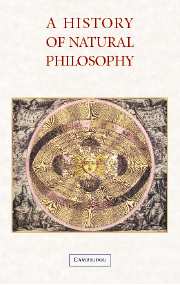Book contents
- Frontmatter
- Contents
- Preface
- 1 Ancient Egypt to Plato
- 2 Aristotle (384–322 BC)
- 3 Late Antiquity
- 4 Islam and the Eastward Shift of Aristotelian Natural Philosophy
- 5 Natural Philosophy before the Latin Translations
- 6 Translations in the Twelfth and Thirteenth Centuries
- 7 Natural Philosophy after the Translations: Its Role and Place in the Late Middle Ages
- 8 The Form and Content of Late Medieval Natural Philosophy
- 9 The Relations between Natural Philosophy and Theology
- 10 The Transformation of Medieval Natural Philosophy from the Early Modern Period to the End of the Nineteenth Century
- Conclusion
- Bibliography
- Index
9 - The Relations between Natural Philosophy and Theology
Published online by Cambridge University Press: 05 June 2012
- Frontmatter
- Contents
- Preface
- 1 Ancient Egypt to Plato
- 2 Aristotle (384–322 BC)
- 3 Late Antiquity
- 4 Islam and the Eastward Shift of Aristotelian Natural Philosophy
- 5 Natural Philosophy before the Latin Translations
- 6 Translations in the Twelfth and Thirteenth Centuries
- 7 Natural Philosophy after the Translations: Its Role and Place in the Late Middle Ages
- 8 The Form and Content of Late Medieval Natural Philosophy
- 9 The Relations between Natural Philosophy and Theology
- 10 The Transformation of Medieval Natural Philosophy from the Early Modern Period to the End of the Nineteenth Century
- Conclusion
- Bibliography
- Index
Summary
Although the early centuries of Christianity played a significant role in shaping the relations between natural philosophy and theology in the Middle Ages, developments in the twelfth and thirteenth centuries were more directly relevant in establishing the interplay between these two enormously important disciplines, an interplay that may appropriately be interpreted as surrogate for the relationship between science and religion. Nevertheless, to better appreciate and understand the long-term connections and antipathies between these two disciplines, it is desirable to describe briefly the manner in which they began their relations in the early centuries of the rise and development of Christianity.
When Christianity first emerged within the Roman Empire, pagan culture and literature were already centuries old. The fact that Christianity, in contrast to Islam some centuries later, was disseminated rather slowly – it was not until 392 ad that Christianity became the state religion, almost four centuries after it first emerged – enabled Christians to adjust to pagan philosophy and literature and to contemplate what role, if any, it might play in their religion. Those who were instrumental in shaping the attitudes of the early Church toward pagan philosophy, and especially natural philosophy are known collectively as the Church Fathers. They came to represent two major approaches toward pagan natural philosophy. The first approach was quite hostile, regarding pagan science and philosophy as of little use to Christianity and even potentially harmful.
- Type
- Chapter
- Information
- A History of Natural PhilosophyFrom the Ancient World to the Nineteenth Century, pp. 239 - 273Publisher: Cambridge University PressPrint publication year: 2007



